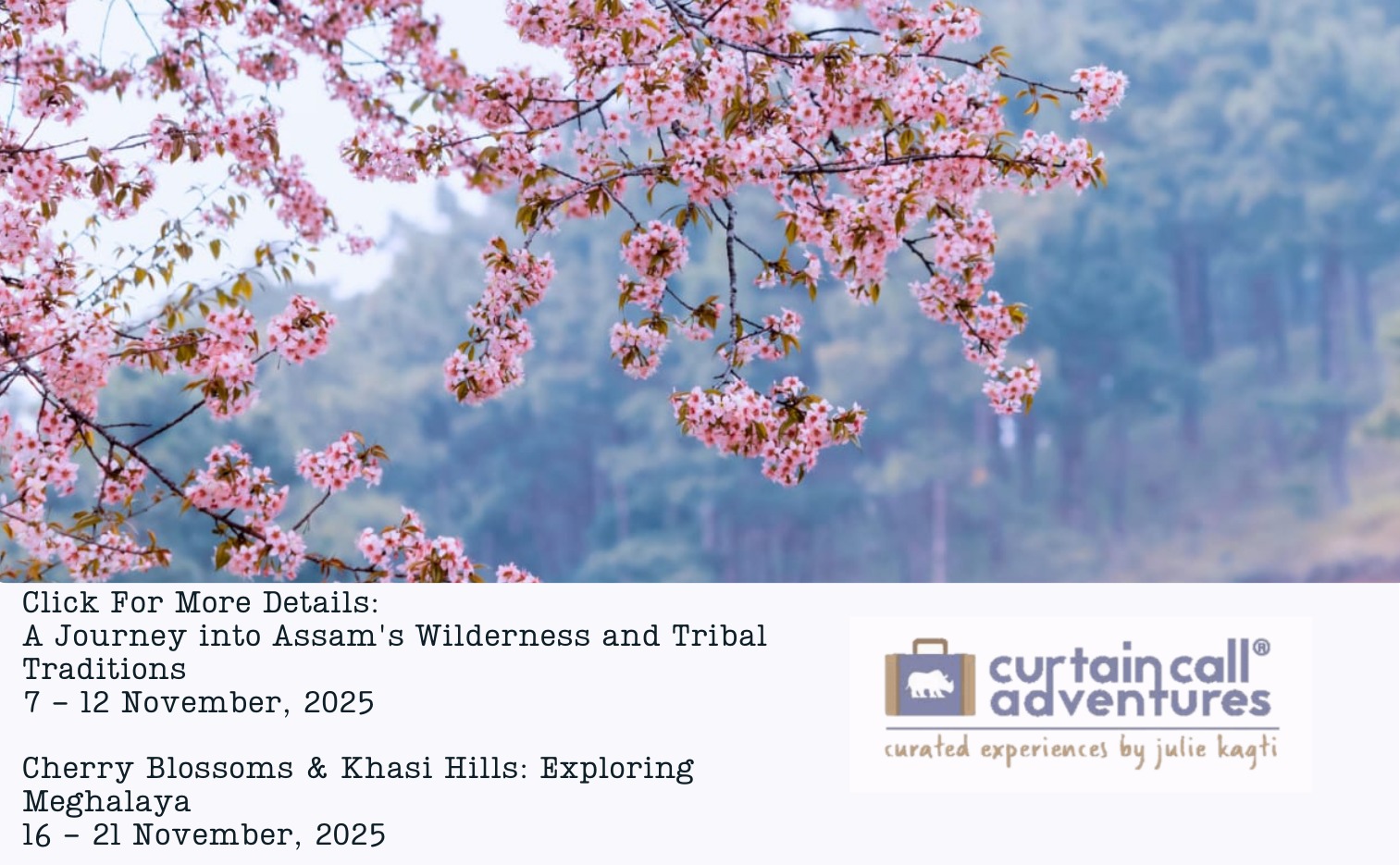Twenty years from now you will be more disappointed by the things you didn’t do than the ones you did do. So throw off the bowlines, Sail away from the safe harbor. Catch the trade winds in your sails. EXPLORE. DREAM. DISCOVER. – Mark Twain
After investing over a quarter of a century in familial responsibilities, in March 2018, I realized it was time now to embark on my DREAM journey to EXPLORE and DISCOVER the unexplored.
My friend Julie Kagti managed to convince me that this was going to be “That Holiday with a Difference”. Brushing aside all my apprehensions and inhibitions, I chose to go on this trip.
I set off on my journey from Guwahati and moved up the Brahmaputra to Kaziranga and Majuli. Every place on this leg of my journey had charmed me with its own beauty and uniqueness of its geography, culture, people, traditions, customs, cuisine & its noteworthy textiles & crafts.
The destination after Majuli was the one I was anxiously waiting for. A ferry ride to Lakhimpur, followed by a long drive through the beautiful densely forested mountains and the river fed valleys of the Himalaya finally made way to my dream destination. The pristine valley of Ziro, carefully tucked away in the hills of Arunachal Pradesh and home to the fascinating Apatani tribe and their annual Myoko Festival.
One of the first things I sighted in Zero were the breathtaking pink and white tree blossoms and tall wooden Totem poles coupled with small altar like bamboo structures with upturned egg shells- markers of the ongoing Miyoko festival.
Over the next three days, our warm, gracious and giggly Apatani local guide Ribiya Taso, was brimming with interesting nuggets of information about his land and its people. The very notion of the existence of such a community in this world felt like a surreal experience. The Apatanis are of Tibetan origin and are one of the twenty-six tribes of Arunachal Pradesh who migrated in mid-19th C from two places – Talley Valley and Biirii to finally settle down in the Ziro valley. They are one of the few tribes in the world who continue to worship the nature and co-exist in complete harmony with it. Worshippers of Donyi Polo (sun & moon), they are an animist tribe who believe in the existence of soul or spirit not only in humans, but also in animals, trees, rocks and all-natural forces and phenomena. One gets to see the worship of all these elements in their rituals, as also in their sacrifice rituals to appease the Gods and invoke the spirits.
Traditionally the Apatani men were hunters and the women were excellent weavers. The Apatani women were also considered the most beautiful in all of Arunachal Pradesh. In order to make them look less appealing to the men of other tribes, they were tattooed on their faces and were made to wear massive nose plugs (a tradition that is not followed anymore). I was fortunate enough to get a glimpse of three generations of these beautiful Apatani women with and without the nose plugs, on my visit to the Hija Basti where we went to witness the Myoko festival. Besides tattoos and nose plugs, bead necklaces also form a distinctive feature of the Apatani women. Beads are a status symbol in the tribal society. They mark the wearer’s social and cultural status and are also one of the most important parts of a girls wedding trousseau mostly inherited from generation to generation. Another striking feature I noticed about the Apatanis is their complete sustainable living. Their age old philosophy of living in harmony and co-existence with nature is what continues to drive them towards a sustainable living in all spheres of their life. Talk about carbon footprint…that too in parts of our country that are considered backward!!
Myoko is a friendship day festival that lasts for ten days from the 20th– 30th March every year. It is also the annual Spring festival of the Apatanis. It is a time to renew and strengthen the ties between friends and families and to worship Donyi Polo for the wellbeing of the villagers and livestock and for better cultivation. Myoko festival is celebrated in a cyclic manner between all the villages and this year three villages – Hong, Hija and Hari Basti were hosting it.
The peculiar bamboo stilt houses of the Apatanis were adorned with the Donyi Polo flags and Totem poles with individual family names soaring high into the skies giving the entire village an air of festivity. (The totem poles are signifiers of a strong male presence in the family and participation in the Myoko festival as well. Traditionally they were also used to perform acrobatics in mid-air, an activity which is now banned). The already buzzing and bustling Basti was soon reverberating with the chants of the processionals dressed in their traditional fineries, who went around the village, invoking the spirits. To get a good view of the procession I had to swiftly clamber on to a balcony. At dawn the next morning, a sacrificial ritual was presided over by the Shaman (Apadana priest). Certain rituals were performed on the sacrificial animals (chickens, pigs or Mithuns – depending upon the social and financial status of the individual) at their altar before the sacrifice.
Ziro offered me an amazingly enriching and an unforgettable bouquet of local experiences. Local market visit to browse through the local produce. Gorging on yummy Momos at a local restaurant. Walking on bunds of the very unique rice plantations. Ambling through the tall bamboo forests. Blissful walk through the pristine Pine forests. Lazing on the grass of Ziro Music festival grounds. Leisurely treading through the Hong Basti which is considered Asia’s 2nd largest village. Picnic lunch amidst the pines at the Dree festival grounds. A peek into the local legend of Dora kulu in the Hija Basti. Breathtaking view of the Ziro valley from the Ziro Point. Indulging in shopping of local textiles & crafts. Lessons in local cuisine. And last but not the least a visit to the local Ethnographic Museum showcasing the life, culture and History of the tribes of Arunachal Pradesh was also organized by Curtain Call Adventures at my request due to my interest in Art, History and Museums.
A visit to Ribiya sister’s marital home in the Hija Basti was an experience that will be cherished for a lifetime. The man of the house was the Chieftain of the local village council (Bulyan). He was dressed in a traditional topknot hairdo held in place by a bamboo stick and sported his chieftain’s Badge with great pride. A treat of Apong (local rice beer), Lal-cha (local tea) and boiled eggs spoke well of their warmth and hospitality. However the star attraction for me was the hearth at the center of the house, typical of all Apatani homes. As it was chilly outside, it felt just wonderfully warm and cozy to huddle around the fire. The warm glow of the fire had dramatically lit the interiors of the bamboo house. The hearth was also the place where meat was hung to roast over slow fire to give it a smoked flavor which would then become a precious festive gift for their guest. At this point the feeling of being in a different place and time had started to creep in…
A Tea Party hosted in our honor by the Apatani women living outside the Basti offered me another opportunity to mingle with the locals. Over home brewed kiwi wine and home grown ragi (millet) pancakes, the conversations lasted for over an hour. Their warmth, simplicity and friendly demeanor was quite overwhelming. As a reciprocal gesture we invited them all over to our hotel for an evening of drinks, dance and dinner. What an unexpectedly beautiful evening it turned out to be!! The Apatani women turned up in their traditional fineries including layers of beads and enthralled us not only with their renditions of “ Bambai se aya mera dost “ and “ Yeh dosti hum nahi todenge”, but also with some local songs dedicated to friendship. It was indeed a touching moment and was hard to say goodbye to these warm-hearted captivating ladies from the beautiful land of Ziro.
As all good things must come to an end, My North East sojourn had also reached its last leg. It was time to pack up and head back to the planes and onward to our urban grind. But the journey was yet not over. The precious experience of simply standing and staring at the sparkling waters of Subansiri, the lush green pines & bamboos, clear blue skies, picture perfect purple mountains, colourful wild flowers and gorgeous pebbles from the river basin. Nature had held me to ransom for over a week with its tranquility, serenity and un-spoilt beauty. It was hard to let go off!!
The incredible journey to Ziro has for me unraveled the mysteries of another world existing out there… A world that is still pristine and beckoning with the warmth of its people.
Article by Anita Yewale. She curates programs for the Dr. Bhau Daji Lad museum in Mumbai and conducts interactive workshops for children and parents centered around the history of the Mumbai. Check out her Instagram handle – aathila.aoi.
Image courtesy – Cyril Hinda ( the main article image) and Anita Yewale.


